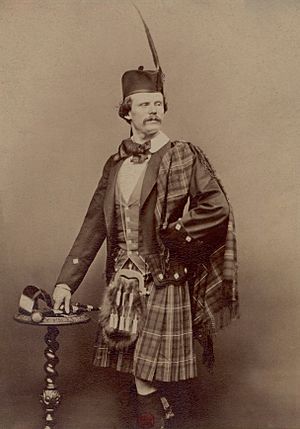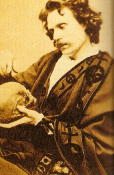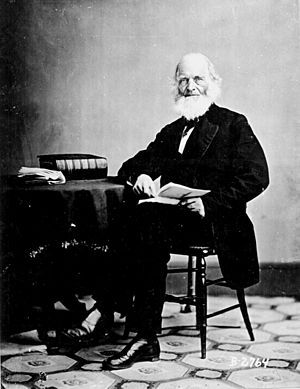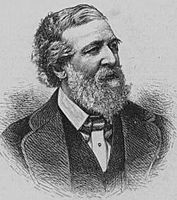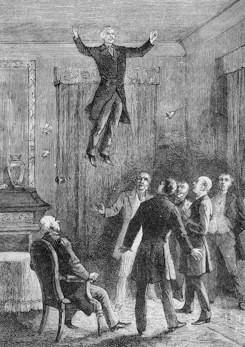Daniel Dunglas Home facts for kids
Daniel Dunglas Home (pronounced Hume; 20 March 1833 – 21 June 1886) was a Scottish physical medium with the reported ability to levitate to a variety of heights, speak with the dead, and to produce rapping and knocks in houses at will. His biographer Peter Lamont opines that he was one of the most famous men of his era. Harry Houdini described him as "one of the most conspicuous and lauded of his type and generation" and "the forerunner of the mediums whose forte is fleecing by presuming on the credulity of the public." Home conducted hundreds of séances, which were attended by many eminent Victorians. There have been eyewitness accounts by séance sitters describing conjuring methods and fraud that Home may have employed.
Contents
Family
Daniel Home's mother, Elizabeth ("Betsy") Home (née McNeill) was known as a seer in Scotland, as were many of her predecessors, like her great uncle Colin Uruqhart, and her uncle Mr. McKenzie. The gift of second sight was often seen as a curse, as it foretold instances of tragedy and death. Home's father, William Home, was the illegitimate son of Alexander, the 10th Earl of Home. Evidence supports the elder Home's illegitimacy, as various payments meant for William were made by the 10th Earl. Elizabeth and William were married when he was 19 years old, and found employment at the Balerno paper mill. The Homes moved into one of small houses built in the mill for the workforce, in Currie (six miles south-west of Edinburgh). William was described as a "bitter, morose and unhappy man" who drank, and was often aggressive towards his wife. Elizabeth had eight children while living in the mill house: six sons and two daughters, although their lives were not fully recorded. The eldest, John, later worked in the Balerno mill and eventually managed a paper mill in Philadelphia, Mary drowned in a stream at the age of 12 years in 1846, and Adam died at sea at the age of 17 while en route to Greenland, which Home says he saw in a vision and reportedly confirmed five months later.
Early life
Daniel Home was Elizabeth's third child, and was born on 20 March 1833. He was baptised by the Reverend Mr. Somerville three weeks after his birth at Currie Parish Church on 14 April 1833. The one-year-old Home was deemed a delicate child, having a "nervous temperament", and was passed to Elizabeth's childless sister, Mary Cook. She lived with her husband in the coastal town of Portobello, 3 miles (4.8 km) east of Edinburgh. According to Home, his cradle rocked by itself at the Cooks' house, and he had a vision of a cousin's death, who lived in Linlithgow, to the west of Edinburgh.
United States
Sometime between 1838 and 1841, Home's aunt and uncle decided to emigrate to the United States with their adopted son, sailing in the cheapest class of steerage as they could not afford a cabin. After landing in New York, the Cooks travelled to Greeneville, near Norwich, Connecticut. The red-haired and freckled Home attended school in Greeneville, where he was known as "Scotchy" by the other students. The 13-year-old Home did not join in sports games with other boys, preferring to take walks in the local woods with a friend called Edwin. The two boys read the Bible to each other and told stories, and made a pact stating that if one or the other were to die, they would try to make contact after death. Home and his aunt soon moved to Troy, New York, which is about 155 miles (249 km) from Greeneville, although Home in his own book stated it was 300 miles (480 km) away. Home lost contact with Edwin until one night when Home, according to Lamont, saw a brightly lit vision of him standing at the foot of the bed, which gave Home the feeling that his friend was dead. Edwin made three circles in the air before disappearing, and a few days later a letter arrived stating that Edwin had died of malignant dysentery three days before Home's vision.
A few years later Home and his aunt returned to Greeneville, and Elizabeth Home emigrated from Scotland to America with the surviving members of the family to live in Waterford, Connecticut, which was 12 miles (19 km) away from the Cook's house. Home and his mother's reunion was short-lived, as Elizabeth appeared to foretell her own death in 1850. Home said he saw his mother in a vision saying, "Dan, 12 o'clock", which was the time of her death. After Elizabeth's death Home turned to religion. His aunt was a Presbyterian, and held the Calvinist view that one's fate has been decided, so Home embraced the Wesleyan faith, which believed that every soul can be saved. Home's aunt resented Wesleyans so much that she forced Home to change to Congregationalist, which was not to her liking, either, but was more in line with her own religion. The house was reportedly disturbed by rappings and knocking similar to those that had occurred two years earlier at the home of the Fox sisters. Ministers were called to the Cooks' house: a Baptist, a Congregationalist, and even a Wesleyan minister, who all believed that Home was possessed by the Devil, although Home believed it was a gift from God. According to Home, the knocking did not stop, and a table started to move by itself, even though Home's aunt put a bible on it and then placed her full body weight on it. According to Lamont, the noises did not stop and were attracting the unwanted attention of Cook's neighbours, so Home was told to leave the house.
Fame
The 18-year-old Home stayed with a friend in Willimantic, Connecticut, and later Lebanon, Connecticut. Home held his first séance in March 1851, which was reported in a Hartford newspaper managed by W. R. Hayden, who wrote that the table moved without anyone touching it, and kept moving when Hayden physically tried to stop it. After the newspaper report, Home became well known in New England, travelling around healing the sick and communicating with the dead, although he wrote that he was not prepared for this sudden change in his life because of his supposed shyness.
Home never directly asked for money, although he lived very well on gifts, donations and lodging from wealthy admirers. He felt that he was on a "mission to demonstrate immortality", and wished to interact with his clients as one gentleman to another, rather than as an employee. In 1852, Home was a guest at the house of Rufus Elmer in Springfield, Massachusetts, giving séances six or seven times a day, which were visited by crowds of people, including a Harvard professor, David Wells, and the poet and editor of the New York Evening Post, William Cullen Bryant. They were all convinced of Home's credibility and wrote to the Springfield Republican newspaper stating that the room was well lit, full inspections were allowed, and said, "We know that we were not imposed upon nor deceived". It was also reported that at one of Home's demonstrations five men of heavy build (with a combined weight of 850 pounds) sat on a table, but it still moved, and others saw "a tremulous phosphorescent light gleam over the walls". Home was investigated by numerous people, such as Professor Robert Hare, the inventor of the oxy-hydrogen blowpipe, and John W. Edmonds, a trial court judge, who were sceptical, but later said they believed Home was not fraudulent.
In his book, "Incidents in My Life", Home claims that in August 1852, in South Manchester, Connecticut, at the house of Ward Cheney, a successful silk manufacturer, he was reportedly seen to levitate twice and then rise to up to the ceiling, with louder rappings and knocking than ever before, more aggressive table movements and the sounds of a ship at sea in a storm, although persons present said that the room was badly lit so as to see the spirit lights.
New York was now interested in Home's abilities, so he moved to an apartment at Bryant Park on 42nd street. His most verbal critic in New York was William Makepeace Thackeray, the author of Vanity Fair. Thackeray dismissed Home's abilities as "dire humbug", and "dreary and foolish superstition", although Thackeray had been impressed when he saw a table turning. Home thought that Thackeray was "the most sceptical inquirer" he had ever met, and as Thackeray made his thoughts public, Home faced public scepticism and further scrutiny. Home travelled between Hartford, Springfield, and Boston during the next few months, and settled in Newburgh by the Hudson River in the summer of 1853. He resided at the Theological Institute, but took no part in any of the theological discussions held there, as he wanted to take a course in medicine. Dr. Hull funded Home's studies, and offered to pay Home five dollars a day for his séances, but Home refused, as always. His idea was to fund his work with a legitimate salary by practicing medicine, but he became ill in early 1854, and stopped his studies. Home was diagnosed with Tuberculosis, and his doctors recommended recuperation in Europe. His last séance in America was in March 1855, in Hartford, Connecticut, before he travelled to Boston and sailed to England on board the Africa, at the end of March.
Europe
Home's name was originally Daniel Home, but by the time he arrived in Europe he had lengthened it to Daniel Dunglas Home, in reference to the Scottish house of Home, of which his father claimed to be a part. In London, Home found a believer in spiritualism, William Cox, who owned a large hotel at 53, 54 and 55 Jermyn Street, London. As Cox was so enamoured of Home's abilities, he let him stay at the hotel without payment. Robert Owen, an 83-year-old social reformer, was also staying at the hotel, and introduced Home to many of his friends in London society. At the time Home was described as "tall and thin, with blue eyes and auburn hair, fastidiously dressed but seriously ill with consumption". Nevertheless, he held sittings for notable people in full daylight, moving objects that were some distance away.
Some early guests at Home's sittings included the scientist Sir David Brewster (who remained unconvinced), the novelists Sir Edward Bulwer-Lytton and Thomas Adolphus Trollope, and the Swedenborgian James John Garth Wilkinson. As well as Brewster, fellow scientists Michael Faraday and Thomas Huxley were prominent contemporary critics of Home's claims. It was the poet Robert Browning however, who proved to be one of Home's most adamant critics. After attending a séance of Home's, Browning wrote in a letter to The Times that: 'the whole display of hands, spirit utterances etc., was a cheat and imposture'. Browning gave his unflattering impression of Home in the poem, "Sludge the Medium" (1864). His wife, Elizabeth Barrett Browning, was convinced that the phenomena she witnessed were genuine and their discussions about Home were a constant source of disagreement. Frank Podmore writes of a Mr Merrifield's first-hand account of experiencing Home's fraudulence during a séance.
Home's fame grew, fuelled by his ostensible feats of levitation. William Crookes claimed Home could levitate five to seven feet above the floor. Crookes wrote "We all saw him rise from the ground slowly to a height of about six inches, remain there for about ten seconds, and then slowly descend."
In the following years Home travelled across continental Europe, and always as a guest of wealthy patrons. In Paris, he was summoned to the Tuileries to perform a séance for Napoleon III. He also performed for Queen Sophia of the Netherlands, who wrote: "I saw him four times...I felt a hand tipping my finger; I saw a heavy golden bell moving alone from one person to another; I saw my handkerchief move alone and return to me with a knot... He himself is a pale, sickly, rather handsome young man but without a look or anything which would either fascinate or frighten you. It is wonderful. I am so glad I have seen it..."
In 1866, Mrs Jane Lyon, a wealthy widow, adopted Home as her son, giving him £60,000 in an attempt to gain introduction into high society. Finding that the adoption did not change her social situation, Lyon changed her mind, and brought a suit for the return of her money from Home on the grounds that it had been obtained by spiritual influence. Under British law, the defendant bears the burden of proof in such a case, and proof was impossible since there was no physical evidence. The case was decided against Home, Mrs Lyon's money was returned, and the press pilloried Home's reputation. Home's high society acquaintances thought that he behaved like a complete gentleman throughout the ordeal, and he did not lose a single important friend.
Sir Arthur Conan Doyle, a spiritualist who supported the mediumship of Home, stated that he was unusual in that he had four different types of mediumship: direct voice (the ability to let spirits audibly speak); trance speaker (the ability to let spirits speak through oneself); clairvoyant (ability to see things that are out of view); and physical medium (moving objects at a distance, levitation, etc., which was the type of mediumship in which he had no equal).
According to Eric Dingwall, a lady acted as a medium and used to help Home during the séances attended by Henrietta Ada Ward.
Alleged levitations
A feat of low levitation by Daniel Dunglas Home was recorded by paranormal historian Frank Podmore. "We all saw him rise from the ground slowly to a height of about six inches, remain there for about ten seconds, and then slowly descend." The Balducci levitation is a levitation illusion first described by Ed Balducci. Its inventor is unknown. The performer stands at an angle facing away from the spectators. The performer appears to levitate a few inches above the ground. The effect generally does not last for more than five seconds. The performer's feet return to the ground, and the effect is complete.
Home met one of his future closest friends in 1867; the young Lord Adare (later the 4th Earl of Dunraven). Adare was fascinated by Home, and began documenting the séances they held. The following year, Home was said to have levitated out of the third storey window of one room, and back in through the window of the adjoining room in front of three witnesses (Adare, Captain Wynne, and Lord Lindsay).
Lord Adare stated that Home "swung out and in" of a window in a horizontal position.
Trevor H. Hall who researched the case in detail established that the levitation took place at Ashley Place in Westminster at a height of 35 feet and suggested rather than levitating Home had stepped across a gap of four feet between two iron balconies. Gordon Stein also noted that the gap between the two balconies was only four feet making passing between them entirely feasible.
A few days before the levitation, scaring Lord Lindsay, Home had opened the same window, stepped out and stood on the outside ledge in the presence of two witnesses. Ivor Lloyd Tuckett argued that Home did this to provide "a rough sketch of the picture which he aimed at producing". Another possible natural explanation for Home's famous levitation was proposed by the psychical researcher Guy William Lambert who suggested he had attached a rope to the chimneys on the roof of the building, and hung the rope down unseen to the third floor. During the alleged levitation Home "swung out and in" the room by using a double rope maneuver. Lambert's rope hypothesis was supported by the magician John Booth.
Arthur Conan Doyle said there were many cases on record of Home levitating, but skeptics assert the alleged levitations occurred in darkened conditions susceptible to trickery.
Science historian Sherrie Lynne Lyons has stated that a possible explanation for Home's alleged levitation phenomena was revealed in the twentieth century by Clarence E. Willard (1882–1962). Willard revealed his technique in 1958 to members of the Society of American Magicians. He demonstrated how he could add two inches to his height by stretching. According to Lyons "it is quite likely that [Home] used a similar technique to the one that Willard used decades later".
Author Donald Serrell Thomas has asserted that Jean Eugène Robert-Houdin, the French stage magician was refused admission to Home's séances. In opposition to this, spiritualists have said that Houdin was unable to explain the phenomena at a Home séance.
Historian Simon During has suggested the levitation of Home was a magic trick, influenced by Robert-Houdin.
Personal life
Home married twice. In 1858, he married Alexandria de Kroll ("Sacha"), the 17-year-old daughter of a noble Russian family, in Saint Petersburg. His Best Man was the writer Alexandre Dumas. They had a son, Gregoire ("Grisha"), but Alexandria fell ill with tuberculosis, and died in 1862. In October 1871, Home married for the second, and last time, to Julie de Gloumeline, a wealthy Russian, whom he also met in St Petersburg. In the process, he converted to the Greek Orthodox faith.
In 1869 Lord Adare revealed in his diaries under the title Experiences in Spiritualism with D. D. Home that he had slept in the same bed with Home. .....
Death
Home retired due to ill health; the tuberculosis, from which he had suffered for much of his life, was advancing and he said his powers were failing. He died on 21 June 1886 at the age of 53 and was buried in the Russian cemetery of St. Germain-en-Laye, in Paris.
See also
 In Spanish: Daniel Dunglas Home para niños
In Spanish: Daniel Dunglas Home para niños


